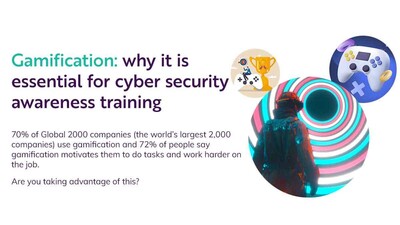
- Ransomware
- 8 min read


The nature of everyday work environments has changed … and so too has the way employees learn in the workplace. Organisations must use innovative ways to facilitate these changes and find training solutions that meet the complex needs of all employees.
Traditional methods of cyber security awareness training can fall short in engaging participants effectively, especially when trying to capture an employee base consisting of multiple generations, methods of learning and interests … enter gamification.
Gamification is a dynamic and interactive approach that must be included in your cyber security awareness framework for maximum ROI.
In fact, 72% of people say gamification motivates them to do tasks and work harder on the job. And you can’t stand still in this space; as of now, experts report that as much as 70% of Global 2000 companies (the world’s largest 2,000 companies) use gamification.
In this blog, we will delve into the world of gamification and explore why it is essential for cyber security awareness training. Whether you're a CISO, DPO or SRI, this article will shed light on the transformative power of gamification.
Gamification is the integration of game-like elements and mechanics into non-game contexts, such as learning and training environments. It leverages the principles of game design to engage and motivate participants, making tasks more enjoyable and encouraging active participation.
In the context of cyber security threats and risks, you will find games that train employees to be better at password management and security, ones that play with data classification protocols, some that simulate phishing scenarios and so on …
Gamifying training requires the transfer of certain gaming elements into the educational and training space. These include:
Conversely, Sailer and Homner recently authored a thorough meta-analysis on gamification in learning. After selecting 38 of the most eligible studies from a total of 1000, they concluded that gamification only requires two things: game fiction and social interaction. Game fiction is the use of narrative tools such as stories, avatars, and an explorable space to immerse and situate learnings in a particular context. Game increases effort and, therefore, increases investment. Social interaction creates a connection in your organisation, a kinship, that leads to healthy competition and collaboration. Features such as a leaderboard can offer a sense of constructive competition as they are understood to be good-natured.
Gamification offers a range of benefits, which is why it has gained popularity in cyber security awareness training:
The current challenge:
Traditional cyber security training methods, such as lectures and e-learning modules, can be a struggle for some participants. At their least effective, they can be dry, lengthy, and fail to capture the urgency of the cyber security landscape.
Furthermore, as more and more younger employees enter the workforce, compliance-based learning that simply aims to tick boxes, will be seen as corporate mumbo jumbo that can be ignored and disregarded.
Gamification as the solution:
Gamification addresses these challenges head-on by turning training into an engaging experience. By applying game elements to cyber security awareness, organisations can bridge the gap between theoretical knowledge and practical application. According to a survey conducted by Adobe, 79% of respondents agreed that if learning were more like a game, learners would be more engaged and driven.
Gamification also allows you to capture employees who do not respond positively to passive eLearning modules but are much more receptive to interactive and active materials. Instead of plunging them into a 10-minute course on phishing, why not drop them into a phishing simulation game and teach them with scenario-based training?
While traditional training offers a formally structured environment to transfer a body of knowledge, gamification goes far beyond, offering opportunities to practice in simulated environments safely in immersive, relevant conditions. This is especially important in areas where students may not fully appreciate or understand the need for them to acquire the knowledge and skills being taught – such as cyber security threats and risks.
Just wanting a gamified learning experience doesn’t mean it is going to be successful. Poor planning can lead to poor ROI when it comes to gamification and as awareness and behavioural experts, this is frustrating to see. According to Zippia, an estimated 80% of workplace gamification fail to meet company objectives because they have been poorly planned and designed, lacking creativity and purpose.
To truly make the most of gamification, here are some steps to maximise the effectiveness of your implementation.
The Octalysis Framework, developed by Yu-kai Chou, is a powerful tool for designing gamified experiences. Based on 10 years of research and study, it breaks down motivation into eight core drives, providing a structured approach to designing engaging games:
Every notch on The Octalysis Framework can also encourage a dopamine release, especially when associated with gaming. The human body releases far more dopamine when it is invested in an enjoyable or challenging or frustrating narrative experience. With gamification, elements such as score, rankings, and prizes to keep players engaged all signal a dopamine release.
Gamification employs various learning mechanics to enhance engagement and knowledge retention:
Duolingo
Duolingo, a language learning app, effectively utilises gamification by incorporating points, levels, and leaderboards. Users are motivated to learn languages through interactive challenges and progress tracking.
Dmitri Medeleev
The Periodic Table of Elements is attributed to Dmitri Mendeleev, a Russian scientist, and educator from the 19th century. Mendeleev was an avid card player, and he used a card game to organise the elements in a form that made sense to him. He used a narrative device he was already familiar with, a card game, to learn how elements, something he was still learning about, interacted with each other.
Sumo Logic
In 2020, Sumo Logic, a cloud-based management organisation, implemented gamification in its security awareness and training campaign to massive success. George Gerchow, CSO at Sumo Logic, told InfoSecurity Professional Magazine that he had seen a 10% reduction in user risk: “Over the course of this last year, we had a 10% reduction in end user risk. Most organisations, when they get compromised, it happens because an end user has a weak password, gets phished or downloads malware. The amount of education you need to do around these things is incredible. One percent to 2% is a win, but a 10% reduction is remarkable”.
While gamification is a powerful approach, it's not the only option for enhancing cyber security awareness. Other interactive training methods include:
90% of employees say gamification makes them more productive at work.
Gamification, with its engaging and interactive nature, offers an effective solution to enhance cyber security awareness training – you simply cannot afford to ignore it.
Whether you are a CISO, DPO, SRI, or simply someone interested in cyber security, embracing gamification can transform the way we educate and prepare our workforce to defend against cyber threats.
By understanding its benefits, implementing effective gamification strategies, and exploring other interactive training methods, organisations can foster a cyber security-aware culture that is vigilant, proactive, and well-prepared for the challenges of the digital world.
If you would like information about how The Security Company can help you to formulate a cyber security training and awareness program for your critical infrastructure organisation or if you would like a demo of our games ... please contact our Head of Business Development and Sales, Jenny Mandley.
The Security Company's vast library of customised and non-customised products and services are tailored for small, medium and large organisations and are available in a variety of languages. We also offer bespoke solutions for organisations that desire training and awareness materials built from the ground up.



© The Security Company (International) Limited 2025
Office One, 1 Coldbath Square, London, EC1R 5HL, UK
Company registration No: 3703393
VAT No: 385 8337 51


